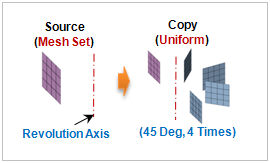Select
the node, element or mesh set to rotate move (or copy)
and define the revolution axis.

Rotation
Axis
Select the move/copy
revolution axis with respect to the GCS or for the 2 points
vector function, input the start and end point coordinates
of the direction vector. It is useful when setting the
reference axis in an arbitrary direction.
When using the
GCS, use the [Locate] option to set the rotation axis
position using its coordinates. The rotation axis is moved
to the specified coordinate position and the node is rotated
and moved/copied about this axis.
For the 2 points
vector function, select (deselect) a particular coordinate
axis and select only the directional comp1nt of a vector
defined by a start and end point.
Methodology
Specify the rotation
angle and rotation copy angle. A uniform angle or arbitrarily
set non-uniform angle can be used to rotate and move/copy.
[Move]
Directly input
the rotation angle.
[Copy (Uniform)]
Set the rotation
angle and number of repetitions. Input a negative to rotate
in the opposite direction to the set direction.
[Copy (Non-uniform)]
The angle can
be listed using a comma (,) or as number@angle for continuously
repeating angles.
For example, entering
10@30 continuously creates 10 elements that are rotated
30 degrees from the previous element and entering 20,30,40
creates 3 elements, each rotated and moved/copied by 20
degrees, 30 degrees and 40 degrees.
Copy Prestress for 1D Elements
If
the anchor is modeled as a 1D element and the prestress
load is entered, the load information is also copied when
copying the anchor. |
